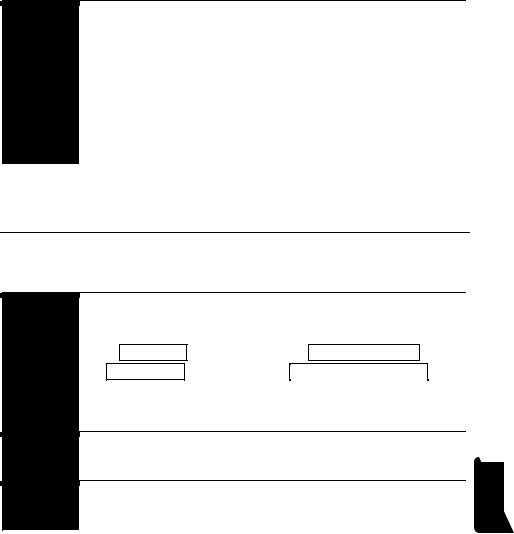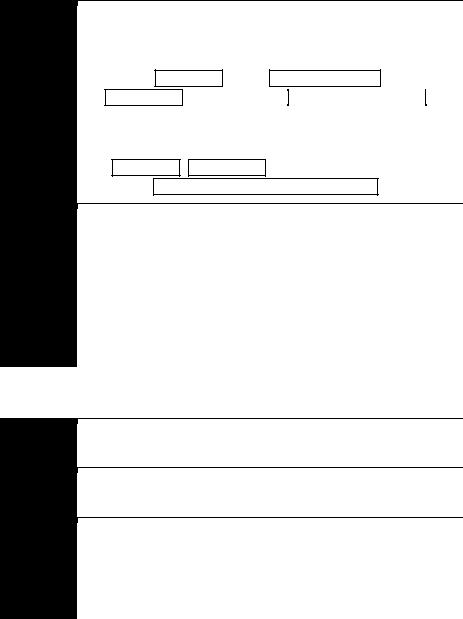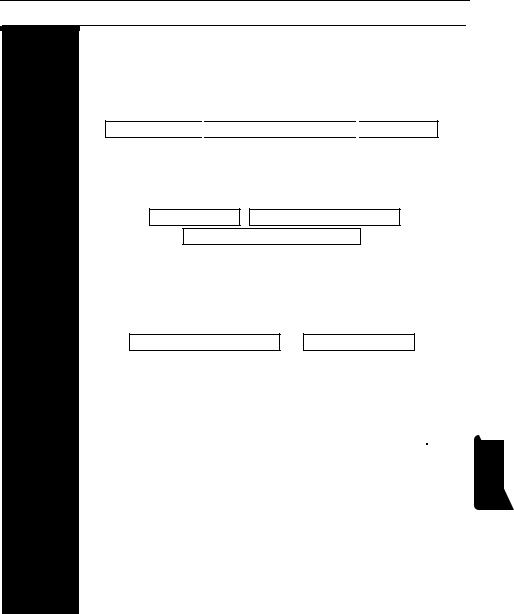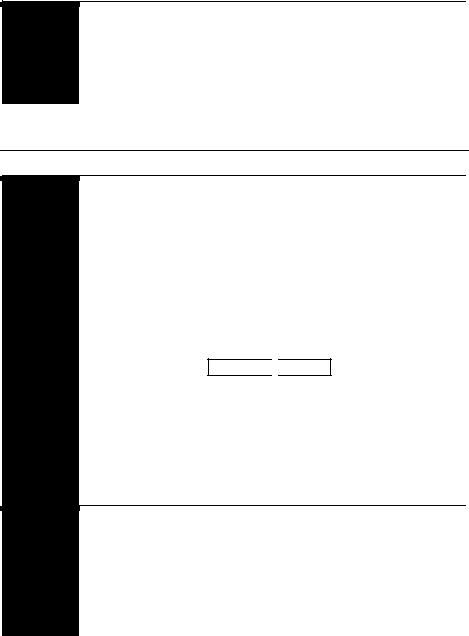
LAW / Referencing for Law Students / AGLC 3rd ed
.pdf
120 Part III — Secondary Sources
Examples
Note
‘Above n’ should be used for all materials in this chapter (in accordance with rule 1.4.2), except for:
•parliamentary debates (rule 6.1.1);
•evidence to parliamentary committees (rule 6.1.6);
•Australian constitutional convention debates (rule 6.1.9);
•interviews (rule 6.13); and
•written correspondence (rule 6.14)
Subsequent references to these listed sources (other than those using ‘ibid’) should appear in full.
5 Commonwealth, Parliamentary Debates, House of Representatives, 26 October 2009, 10 858 (Kevin Rudd, Prime Minister).
6 Ibid.
…
17 Commonwealth, Parliamentary Debates, House of Representatives, 26 October 2009, 10 858 (Kevin Rudd, Prime Minister). [Not: Commonwealth, above n 5, 10 858.]
18Jyoti Rahman, David Stephan and Gene Tunny, ‘Estimating Trends in Australia’s Productivity’ (Working Paper No 2009-01, Treasury, Australian Government, 2 February 2009) 12 <http://www. treasury.gov.au/documents/1466/PDF/Trends%20in%20Australia %27s%20Productivity.pdf>.
19Ibid 15.
…
58Rahman, Stephan and Tunny, above n 18, 14.
59Mad Max 2 (Directed by George Miller, Kennedy Miller Productions, 1981) 1:20.
…
70 Mad Max 2, above n 59, 0:55.
In accordance with rule 1.4.2, short titles may be included in the initial citations of, and replace author names in ‘above n’ references to, reports and similar documents.

|
|
|
|
|
|
|
|
121 |
7 |
Treaties |
|
|
|
|
|
||
|
|
|
|
|
|
|
|
|
|
|
|
Treaty on the |
|
opened for |
729 |
(entered |
|
|
|
|
Non-Proliferation |
|
into force |
|
||
|
|
|
|
signature 1 |
UNTS |
art 3 |
||
|
|
|
of Nuclear |
|
July 1968, |
161 |
5 March |
|
|
|
|
Weapons, |
|
1970) |
|
||
|
|
|
|
|
|
|
||
|
|
|
|
|
|
|
|
|
|
|
|
Agreement |
|
|
|
|
|
|
|
|
regarding the |
|
|
|
(entered |
|
|
|
Examples |
Transfer of the |
Denmark– |
signed 12 |
8 |
into force |
|
|
|
Administration of |
LNTS |
17 |
art 2 |
|||
|
|
Germany, |
July 1921, |
|||||
|
|
|
Justice in the |
|
|
397 |
January |
|
|
|
|
Territories of |
|
|
|
1922) |
|
|
|
|
Northern Slesvig, |
|
|
|
|
|
|
|
|
|
|
|
|
|
|
|
|
|
Statute of the |
|
opened for |
[2009] |
(not yet |
|
|
|
|
International |
|
signature |
ATNIF |
art V |
|
|
|
|
Renewable |
|
26 January |
in force) |
||
|
|
|
Energy Agency, |
|
2009, |
23 |
|
|
|
|
|
|
|
|
|
||
|
|
|
|
|
|
|
|
|
|
|
|
|
|
Date |
|
Date of |
|
|
|
|
|
|
Opened |
|
|
|
|
|
|
|
Parties’ |
Treaty |
Entry |
Pin- |
|
|
|
Element |
Treaty Title |
for |
||||
|
|
Names |
Series |
into |
point |
|||
|
|
|
|
Signature |
||||
|
|
|
|
|
|
Force |
|
|
|
|
|
|
|
or Signed |
|
|
|
|
|
|
|
|
|
|
|
|
|
|
|
|
|
|
|
|
|
|
|
Rule |
7.1 |
7.2 |
7.3 |
7.4 |
7.3 |
7.5 |
|
|
|
|
|
|
|
|
|
7.1Treaty Title
Rule A citation to a treaty should include the treaty title in italics as it appears on the first page of the treaty. However:
•purely procedural components of the title (which are not part of the substantive name, such as the date and place of signature) should be omitted;
Treaties

122 Part IV — International Materials
Example
Note
•punctuation should adhere to rule 1.6.1 (so full stops should not be used in abbreviations); and
•capitalisation should adhere to rule 1.7.
International Covenant on Economic, Social and Cultural Rights, opened for signature 16 December 1966, 993 UNTS 3 (entered into force 3 November 1976). [Not: International Covenant on Economic, Social and Cultural Rights. Adopted by the General Assembly of the United Nations on 16 December 1966, opened for signature …]
If parties’ names are included in the treaty title, they should be reproduced in citations exactly as they appear in that title, even if they appear in an elaborate form.
7.2Parties’ Names
Rule
Examples
For multilateral treaties with more than three signatories, the names of states parties should not be included after the treaty title.
If the names of states parties to a bilateral or trilateral treaty appear in the treaty title, they should not be repeated after the title. If they do not appear in the title, they should be included (unitalicised) after the treaty title, preceded and followed by a comma and joined by endashes.
The conventional shortened forms of states parties’ names should be used (if any exist), rather than their full elaborate forms (for example, ‘Venezuela’, not ‘Bolivarian Republic of Venezuela’). However, the full form should be used if necessary to avoid ambiguity (for example, to differentiate the ‘Democratic Republic of the Congo’ from the ‘Republic of the Congo’).
Convention Relating to the Non-Fortification and Neutralisation of the Aaland Islands, opened for signature 20 October 1921, 9 LNTS 211 (entered into force 6 April 1922). [Not: … Aaland Islands, Germany–Denmark–Estonia–Finland–France etc …]

Australian Guide to Legal Citation 123
Agreement on Cultural and Educative Integration between the Republic of Venezuela and the Republic of Peru, signed 12 January 1996, 2408 UNTS 125 (entered into force 13 March 1997) art 4. [Not:
… between the Republic of Venezuela and the Republic of Peru,
Venezuela–Peru, signed …]
International Agreement on the Scheldt, Belgium–France– Netherlands, signed 3 December 2002, 2351 UNTS 13 (entered into force 1 December 2005) art 3(1)(a).
7.3Date Opened for Signature or Signed and Date of Entry into Force
7.3.1‘Opened for Signature’ (Open Multilateral Treaties)
Rule Multilateral treaties that are opened for signature to states generally should be cited as follows:
Treaty Title , opened for signature Date of Conclusion ,
Treaty Series (entered into force Date of Entry into Force ).
The date of entry into force is the date on which the treaty first commences for any state party.
Example Convention Relating to the Status of Refugees, opened for signature 28 July 1951, 189 UNTS 150 (entered into force 22 April 1954).
Note Where a treaty is adopted by the United Nations General Assembly, the date of adoption is generally the date of conclusion.
Treaties

124 Part IV — International Materials
7.3.2Signed by All Parties (Closed Multilateral or Bilateral Treaties)
Rule
Examples
Treaties that are signed by all parties and are not opened for signature to others (often bilateral and trilateral treaties) should be cited as follows:
Treaty Title , signed Date of Conclusion ,
Treaty Series (entered into force Date of Entry into Force ).
Where the date of conclusion and entry into force are the same, such treaties should be cited as follows:
Treaty Title , Treaty Series (signed and entered into force Date of Conclusion and Entry into Force ).
Agreement between the Government of Australia and the Government of the United Kingdom of Great Britain and Northern Ireland Providing for the Reciprocal Recognition and Enforcement of Judgments in Civil and Commercial Matters, signed 23 August 1990, [1994] ATS 27 (entered into force 1 September 1994).
Agreement Relating to Co-operation on Antitrust Matters, Australia– United States of America, 1369 UNTS 43 (signed and entered into force 29 June 1982).
7.3.3Treaties Not Yet in Force
Rule
Example
Note
For treaties that are not yet in force, ‘(not yet in force)’ should replace the date of entry into force.
Convention on Cluster Munitions, opened for signature 3 December 2008, [2008] ATNIF 24 (not yet in force).
Drafts of treaties should be cited in accordance with the appropriate rules of this Guide for the source type. They are commonly contained in UN documents (see chapter 8). Where it is not otherwise apparent that a reference is to a draft treaty, this should be clarified discursively.

Australian Guide to Legal Citation 125
7.4Treaty Series
Rule A citation to a treaty series should be included and the series name should be abbreviated.
Where the treaty series is organised by volume, the citation should appear as follows:
Volume Number 
 Treaty Series Abbreviation
Treaty Series Abbreviation 
 Starting Page (for example, ‘23 UNTS 35’).
Starting Page (for example, ‘23 UNTS 35’).
Where the treaty series is organised by year, the citation should appear as follows:
[ Year of Volume ] Treaty Series Abbreviation Starting Page or Treaty Number
(for example, ‘[2010] ATS 5’).
Where the treaty series is organised by sequential order of deposit independent of year (that is, the treaty is the nth treaty ever deposited in the series), the citation should appear as follows:
Treaty Series Abbreviation No Sequential Number (for example, ‘CETS No 207’).
Parallel citations should not be used.
For treaties to which Australia is a party, the following treaty series and abbreviations should be used:
Treaty Series |
|
Abbreviation |
|
|
|
United Nations Treaty Series |
|
UNTS |
League of Nations Treaty Series |
|
LNTS |
Australian Treaty Series |
|
ATS |
Australian Treaties Not Yet in Force |
|
ATNIF |
ATS or ATNIF should only be used where the treaty is not reported in the UNTS or LNTS. Where the treaty is not reported in these treaty series, the other treaty series listed below should be used.
Treaties

126 Part IV — International Materials
For treaties to which Australia is not party, the following treaty series should be used in order of preference:
•UNTS or LNTS;
•an official treaty series of a state party; or
•another international or regional treaty series.
The latter two categories include:
|
Treaty Series |
|
Abbreviation |
|
|
|
|
|
|
|
Canada Treaty Series |
|
CTS |
|
|
Consolidated Treaty Series |
|
ConTS |
|
|
Council of Europe Treaty Series |
|
CETS |
|
|
European Treaty Series |
|
ETS |
|
|
Pacific Islands Treaty Series |
|
PITS |
|
|
United States Treaties and Other |
|
UTS |
|
|
International Agreements |
|
|
|
For treaties between members of the European Union that do not appear in the UNTS or an official treaty series of a member (as well as in accordance with rule 13.1.2), the Official Journal of the European Union should be cited.
If a treaty is not published in a treaty series, other sources containing the treaty, such as International Legal Materials (abbreviated ‘ILM’), should be cited.
Examples Vienna Convention on the Law of Treaties, opened for signature 23 May 1969, 1155 UNTS 331 (entered into force 27 January 1980).
Agreement between the Government of Australia and the Government of Samoa Relating to Air Services, signed 11 August 2000, [2001] ATS 18 (entered into force 29 October 2001).
Convention on Cybercrime, opened for signature 23 November 2001, ETS No 185 (entered into force 1 July 2004) art 4(1).
Military Convention between Bulgaria and Greece, signed 22 September 1912, 217 ConTS 134 (entered into force 5 October 1912).
Convention on the International Recovery of Child Support and Other Forms of Family Maintenance, opened for signature 23 November 2007, 47 ILM 257 (not yet in force).

Australian Guide to Legal Citation 127
Notes The very first page of a treaty (as it appears in a treaty series) should be included as the starting page, even though this page does not usually indicate a page number and contains only the title, party names and other formal details.
Although International Legal Materials is not technically a treaty series or report series, it may be abbreviated ‘ILM’ and treated for citation purposes as if it were both.
7.5Pinpoint Reference
Rule A pinpoint reference should follow the date of entry into force, preceded by a space. A pinpoint reference should not be preceded by any punctuation.
Pinpoint references should be to the articles, paragraphs, sections, etc, of a treaty. They should not be to the pages of the treaty series. Pinpoint references should adhere to rules 1.1.5–1.1.6. They should use the abbreviations in rule 3.1.4 (for example, ‘art’, ‘para’, ‘s’) as appropriate. In accordance with rule 3.1.4, the highest ‘level’ of article, paragraph, etc, in the pinpoint should be used (for example, ‘art 31.1’, not ‘para 31.1’). The designator ‘annex’ should always be written out in full.
Examples International Convention on the Elimination of All Forms of Racial Discrimination, opened for signature 21 December 1965, 660 UNTS 195 (entered into force 4 January 1969) art 3.
Convention on the Privileges and Immunities of the United Nations, opened for signature 13 February 1946, 1 UNTS 15 (entered into force 17 September 1946) s 9. [Not: … (entered into force 17 September 1946), s 9.]
Agreement Establishing the Advisory Centre on WTO Law, opened for signature 30 November 1999, 2299 UNTS 249 (entered into force 15 July 2001) annex II.
Treaties

128 Part IV — International Materials
Note Articles are commonly separated from paragraphs by parentheses (for example, ‘art 33(1)’) or decimal points (for example, ‘art 33.1’). Both Roman numbering (for example, ‘art XX’) and Arabic numbering (for example, ‘art 12’) are common in treaties. The form of pinpoint reference in the treaty cited should be used in citations.
7.6Subsequent References to Treaties
Rule
Examples
‘Ibid’ should be used for all materials in this chapter (in accordance with rule 1.4.1).
In other subsequent references, citations should appear in full each time a treaty is referred to. However, treaties referred to frequently may be given a short title the first time they are cited. The short title should adhere to rule 1.4.3 (so should be italicised and placed within single inverted commas and parentheses following the initial citation). The short title may be placed in the text or in the footnotes. Subsequent references should take the form:
Short Title 
 Pinpoint .
Pinpoint .
A short title may be given to a portion of a treaty (for example, an annex, an appendix or a schedule) in accordance with rule 1.4.3. The short title should be placed after the pinpoint to the relevant portion. Pinpoints following the short title in subsequent references refer to sections, paragraphs, etc, within that portion of a treaty.
‘Above n’ should not be used for treaties.
15Treaty on the Zone of Cooperation in an Area between the Indonesian Province of East Timor and Northern Australia, signed 11 December 1989, 1654 UNTS 105 (entered into force 9 February 1991) art 4(2)(a) (‘Timor Gap Treaty’).
…
69 Timor Gap Treaty art 6(1).

Australian Guide to Legal Citation 129
70Convention on the Prohibition of the Development, Production, Stockpiling and Use of Chemical Weapons and on Their Destruction, opened for signature 13 January 1993, 1974 UNTS 45 (entered into force 29 April 1997) annex (‘Annex on Chemicals’).
…
73 Annex on Chemicals pt B sch 2 para 2.
Treaties
